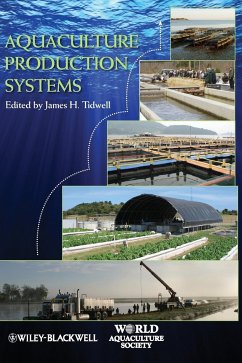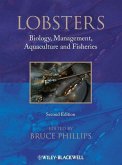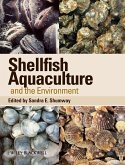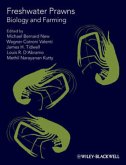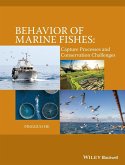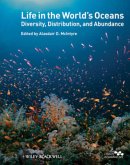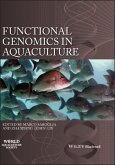James H. Tidwell
Aquaculture Production Systems
James H. Tidwell
Aquaculture Production Systems
- Gebundenes Buch
- Merkliste
- Auf die Merkliste
- Bewerten Bewerten
- Teilen
- Produkt teilen
- Produkterinnerung
- Produkterinnerung
Aquaculture is an increasingly diverse industry with an ever-growing number of species cultured and production systems available to professionals. A basic understanding of production systems is vital to the successful practice of aquaculture.
Published with the World Aquaculture Society, Aquaculture Production Systems captures the huge diversity of production systems used in the production of shellfish and finfish in one concise volume that allows the reader to better understand how aquaculture depends upon and interacts with its environment.
The systems examined range from low input…mehr
Andere Kunden interessierten sich auch für
![Environ Best Mngmnt Aquaculture Environ Best Mngmnt Aquaculture]() Craig S. Tucker / John A. HargreavesEnviron Best Mngmnt Aquaculture244,99 €
Craig S. Tucker / John A. HargreavesEnviron Best Mngmnt Aquaculture244,99 €![Lobsters Lobsters]() Bruce PhillipsLobsters311,99 €
Bruce PhillipsLobsters311,99 €![Shellfish Aquaculture and the Environment Shellfish Aquaculture and the Environment]() Sandra E. ShumwayShellfish Aquaculture and the Environment251,99 €
Sandra E. ShumwayShellfish Aquaculture and the Environment251,99 €![Freshwater Prawns Freshwater Prawns]() Freshwater Prawns288,99 €
Freshwater Prawns288,99 €![Behavior of Marine Fishes Behavior of Marine Fishes]() Pingguo HeBehavior of Marine Fishes272,99 €
Pingguo HeBehavior of Marine Fishes272,99 €![Life in the World's Oceans Life in the World's Oceans]() Life in the World's Oceans247,99 €
Life in the World's Oceans247,99 €![Functional Genomics in Aquaculture Functional Genomics in Aquaculture]() Marco SarogliaFunctional Genomics in Aquaculture237,99 €
Marco SarogliaFunctional Genomics in Aquaculture237,99 €-
-
-
Aquaculture is an increasingly diverse industry with an ever-growing number of species cultured and production systems available to professionals. A basic understanding of production systems is vital to the successful practice of aquaculture.
Published with the World Aquaculture Society, Aquaculture Production Systems captures the huge diversity of production systems used in the production of shellfish and finfish in one concise volume that allows the reader to better understand how aquaculture depends upon and interacts with its environment.
The systems examined range from low input methods to super-intensive systems. Divided into five sections that each focus on a distinct family of systems, Aquaculture Production Systems serves as an excellent text to those just being introduced to aquaculture as well as being a valuable reference to well-established professionals seeking information on production methods.
Hinweis: Dieser Artikel kann nur an eine deutsche Lieferadresse ausgeliefert werden.
Published with the World Aquaculture Society, Aquaculture Production Systems captures the huge diversity of production systems used in the production of shellfish and finfish in one concise volume that allows the reader to better understand how aquaculture depends upon and interacts with its environment.
The systems examined range from low input methods to super-intensive systems. Divided into five sections that each focus on a distinct family of systems, Aquaculture Production Systems serves as an excellent text to those just being introduced to aquaculture as well as being a valuable reference to well-established professionals seeking information on production methods.
Hinweis: Dieser Artikel kann nur an eine deutsche Lieferadresse ausgeliefert werden.
Produktdetails
- Produktdetails
- World Aquaculture Society Book Series
- Verlag: Wiley & Sons
- 1. Auflage
- Seitenzahl: 440
- Erscheinungstermin: 26. Juni 2012
- Englisch
- Abmessung: 260mm x 183mm x 28mm
- Gewicht: 1008g
- ISBN-13: 9780813801261
- ISBN-10: 0813801265
- Artikelnr.: 34546603
- Herstellerkennzeichnung
- Libri GmbH
- Europaallee 1
- 36244 Bad Hersfeld
- gpsr@libri.de
- World Aquaculture Society Book Series
- Verlag: Wiley & Sons
- 1. Auflage
- Seitenzahl: 440
- Erscheinungstermin: 26. Juni 2012
- Englisch
- Abmessung: 260mm x 183mm x 28mm
- Gewicht: 1008g
- ISBN-13: 9780813801261
- ISBN-10: 0813801265
- Artikelnr.: 34546603
- Herstellerkennzeichnung
- Libri GmbH
- Europaallee 1
- 36244 Bad Hersfeld
- gpsr@libri.de
James H. Tidwell is Professor and Chair of the Division of Aquaculture at the Aquaculture Research Center at Kentucky State University.
Contributors xi
Preface xiv
Acknowledgments xvi
1 The Role of Aquaculture 3
James H. Tidwell and Geoff Allan
1.1 Seafood demand 3
1.2 Seafood supply 4
1.3 Seafood trade 6
1.4 Status of aquaculture 7
1.5 Production systems 12
1.6 The future and the challenge 13
1.7 References 13
2 History of Aquaculture 15
Robert R. Stickney and Granvil D. Treece
2.1 Beginnings of aquaculture 16
2.2 Expansion prior to the mid-1800s 17
2.3 The explosion of hatcheries 18
2.4 Art becomes science 20
2.5 Commercial finfish species development 23
2.6 Shrimp culture 33
2.7 Mollusk culture 42
2.8 Controversy 43
2.9 References 44
3 Functions and Characteristics of All Aquaculture Systems 51
James H. Tidwell
3.1 Differences in aquatic and terrestrial livestock 51
3.2 Ecological services provided by aquaculture production systems 53
3.3 Diversity of aquaculture animals 53
3.4 Temperature classifications of aquacultured animals 54
3.5 Temperature control in aquaculture systems 56
3.6 Providing oxygen in aquaculture systems 58
3.7 Waste control in aquaculture systems 59
3.8 Aquaculture systems as providers of natural foods 61
3.9 References 62
4 Characterization and Categories of Aquaculture Production Systems 64
James H. Tidwell
4.1 Open systems 65
4.2 Semi-closed systems 68
4.3 Closed systems 73
4.4 Hybrid systems 75
4.5 References 77
5 Shellfish Aquaculture 79
Robert Rheault
5.1 Major species in culture (oysters, clams, scallops, mussels) 80
5.2 History 81
5.3 Biology 84
5.4 Culture basics 86
5.5 Extensive versus intensive culture 88
5.6 Spat collection: hatchery, nursery, growout 89
5.7 Cultured algae 91
5.8 Spawning 92
5.9 Larval development 93
5.10 Setting 94
5.11 Nursery and growout scale considerations 96
5.12 Nursery methods 97
5.13 Growout methods 100
5.14 Fouling 104
5.15 Fouling control strategies 104
5.16 Predation 105
5.17 Harvest 106
5.18 Food safety 107
5.19 Shellfish diseases 108
5.20 Disease management options 108
5.21 Genetics: selective breeding 109
5.22 Triploidy 110
5.23 Harmful algal blooms 110
5.24 Site selection 111
5.25 Carrying capacity 112
5.26 Permitting challenges 113
5.27 Nonnative species 114
5.28 References 115
6 Cage Culture in Freshwater and Protected Marine Areas 119
Michael P. Masser
6.1 Current status of cage culture 121
6.2 History and evolution of cage culture 122
6.3 Advantages and disadvantages of cages 123
6.4 Site selection 124
6.5 Stocking cages 125
6.6 Feeding caged fish 126
6.7 Polyculture and integrated systems 126
6.8 Problems with cage culture 127
6.9 Economics of cage culture 129
6.10 Sustainability issues 129
6.11 References 130
7 Ocean Cage Culture 135
Richard Langan
7.1 The context for open ocean farming 135
7.2 Characterization and selection of open ocean sites 137
7.3 Technologies for open ocean farming 139
7.4 Finfish species cultivated in open ocean cages 148
7.5 Environmental considerations 149
7.6 Future prospects and challenges 153
7.7 References 154
8 Reservoir Ranching 158
Steven D. Mims and Richard J. Onders
8.1 Reservoir ranching vs. culture-based fisheries 158
8.2 Reservoir 159
8.3 Natural processes of reservoirs 160
8.4 Selection of reservoirs for reservoir ranching 162
8.5 Fish species selection 164
8.6 Stocking density and size 165
8.7 Status of reservoir ranching around the world 166
8.8 Summary 170
8.9 References 171
9 Flow-through Raceways 173
Gary Fornshell, Jeff Hinshaw, and James H. Tidwell
9.1 Types of raceways 174
9.2 Physical requirements 177
9.3 Water requirements 179
9.4 Carrying capacity 180
9.5 Water consumption and waste management 183
9.6 Feeding and inventory management 186
9.7 Summary 187
9.8 References 189
10 Ponds 191
Craig Tucker and John Hargreaves
10.1 Species cultured 193
10.2 Pond types 195
10.3 Water use 198
10.4 Pond culture intensity and ecological services 201
10.5 Food in pond aquaculture 202
10.6 Life support in pond aquaculture 208
10.7 Land use and the ecological footprint of pond aquaculture 222
10.8 Consequences of unregulated algal growth 227
10.9 Practical constraints on pond aquaculture production 230
10.10 Comparative economics of culture systems 234
10.11 Sustainability issues 237
10.12 Trends and research needs 240
10.13 References 242
11 Recirculating Aquaculture Systems 245
James M. Ebeling and Michael B. Timmons
11.1 Positive attributes 246
11.2 Overview of system engineering 247
11.3 Culture tanks 249
11.4 Waste solids removal 250
11.5 Cornell dual-drain system 250
11.6 Settling basins and tanks 252
11.7 Mechanical filters 252
11.8 Granular media filters 253
11.9 Disposal of the solids 254
11.10 Biofiltration 254
11.11 Choice of biofilter 258
11.12 Aeration and oxygenation 259
11.13 Carbon dioxide removal 261
11.14 Monitoring and control 262
11.15 Current system engineering design 262
11.16 Recirculation system design 263
11.17 Four major water-treatment variables 265
11.18 Summary of four production terms 268
11.19 Stocking density 270
11.20 Engineering design example 270
11.21 Conclusion 276
11.22 References 277
12 Biofloc-based Aquaculture Systems 278
Craig L. Browdy, Andrew J. Ray, John W. Leffler, and Yoram Avnimelech
12.1 Bioflocs 280
12.2 Oxygen dynamics 284
12.3 Resuspension, mixing, and sludge management 287
12.4 Nitrogenous waste products 290
12.5 Temperature 296
12.6 Feeds and feeding 297
12.7 Economics 299
12.8 Sustainability 300
12.9 Outlook and research needs 302
12.10 Acknowledgment 303
12.11 References 303
13 Partitioned Aquaculture Systems 308
D. E. Brune, Craig Tucker, Mike Massingill, and Jesse Chappell
13.1 High rate ponds in aquaculture-the partitioned aquaculture system 311
13.2 PAS fingerling production 324
13.3 Flow-through PAS: the controlled eutrophication process 326
13.4 Photoautotrophic and chemoautotrophic PAS for marine shrimp production
329
13.5 Alabama in-pond raceway system 331
13.6 Mississippi split-pond aquaculture system 333
13.7 California pondway system 336
13.8 References 340
14 Aquaponics-Integrating Fish and Plant Culture 343
James E. Rakocy
14.1 System design 345
14.2 Fish production 349
14.3 Solids 352
14.4 Biofiltration 357
14.5 Hydroponic subsystems 360
14.6 Sump 362
14.7 Construction materials 363
14.8 Component ratios 364
14.9 Plant growth requirements 366
14.10 Nutrient dynamics 368
14.11 Vegetable selection 372
14.12 Crop production systems 373
14.13 Pest and disease control 375
14.14 Approaches to system design 376
14.15 Economics 380
14.16 Prospects for the future 382
14.17 References 383
15 In-pond Raceways 387
Michael P. Masser
15.1 Development of the in-pond raceway 388
15.2 Stocking and feeding 390
15.3 Backup systems and disease treatments 391
15.4 Comparison to other culture systems 391
15.5 Sustainability issues 393
15.6 Future trends 393
15.7 References 393
16 On the Drawing Board 395
James H. Tidwell
16.1 Future trends 395
16.2 References 412
Index 415
Preface xiv
Acknowledgments xvi
1 The Role of Aquaculture 3
James H. Tidwell and Geoff Allan
1.1 Seafood demand 3
1.2 Seafood supply 4
1.3 Seafood trade 6
1.4 Status of aquaculture 7
1.5 Production systems 12
1.6 The future and the challenge 13
1.7 References 13
2 History of Aquaculture 15
Robert R. Stickney and Granvil D. Treece
2.1 Beginnings of aquaculture 16
2.2 Expansion prior to the mid-1800s 17
2.3 The explosion of hatcheries 18
2.4 Art becomes science 20
2.5 Commercial finfish species development 23
2.6 Shrimp culture 33
2.7 Mollusk culture 42
2.8 Controversy 43
2.9 References 44
3 Functions and Characteristics of All Aquaculture Systems 51
James H. Tidwell
3.1 Differences in aquatic and terrestrial livestock 51
3.2 Ecological services provided by aquaculture production systems 53
3.3 Diversity of aquaculture animals 53
3.4 Temperature classifications of aquacultured animals 54
3.5 Temperature control in aquaculture systems 56
3.6 Providing oxygen in aquaculture systems 58
3.7 Waste control in aquaculture systems 59
3.8 Aquaculture systems as providers of natural foods 61
3.9 References 62
4 Characterization and Categories of Aquaculture Production Systems 64
James H. Tidwell
4.1 Open systems 65
4.2 Semi-closed systems 68
4.3 Closed systems 73
4.4 Hybrid systems 75
4.5 References 77
5 Shellfish Aquaculture 79
Robert Rheault
5.1 Major species in culture (oysters, clams, scallops, mussels) 80
5.2 History 81
5.3 Biology 84
5.4 Culture basics 86
5.5 Extensive versus intensive culture 88
5.6 Spat collection: hatchery, nursery, growout 89
5.7 Cultured algae 91
5.8 Spawning 92
5.9 Larval development 93
5.10 Setting 94
5.11 Nursery and growout scale considerations 96
5.12 Nursery methods 97
5.13 Growout methods 100
5.14 Fouling 104
5.15 Fouling control strategies 104
5.16 Predation 105
5.17 Harvest 106
5.18 Food safety 107
5.19 Shellfish diseases 108
5.20 Disease management options 108
5.21 Genetics: selective breeding 109
5.22 Triploidy 110
5.23 Harmful algal blooms 110
5.24 Site selection 111
5.25 Carrying capacity 112
5.26 Permitting challenges 113
5.27 Nonnative species 114
5.28 References 115
6 Cage Culture in Freshwater and Protected Marine Areas 119
Michael P. Masser
6.1 Current status of cage culture 121
6.2 History and evolution of cage culture 122
6.3 Advantages and disadvantages of cages 123
6.4 Site selection 124
6.5 Stocking cages 125
6.6 Feeding caged fish 126
6.7 Polyculture and integrated systems 126
6.8 Problems with cage culture 127
6.9 Economics of cage culture 129
6.10 Sustainability issues 129
6.11 References 130
7 Ocean Cage Culture 135
Richard Langan
7.1 The context for open ocean farming 135
7.2 Characterization and selection of open ocean sites 137
7.3 Technologies for open ocean farming 139
7.4 Finfish species cultivated in open ocean cages 148
7.5 Environmental considerations 149
7.6 Future prospects and challenges 153
7.7 References 154
8 Reservoir Ranching 158
Steven D. Mims and Richard J. Onders
8.1 Reservoir ranching vs. culture-based fisheries 158
8.2 Reservoir 159
8.3 Natural processes of reservoirs 160
8.4 Selection of reservoirs for reservoir ranching 162
8.5 Fish species selection 164
8.6 Stocking density and size 165
8.7 Status of reservoir ranching around the world 166
8.8 Summary 170
8.9 References 171
9 Flow-through Raceways 173
Gary Fornshell, Jeff Hinshaw, and James H. Tidwell
9.1 Types of raceways 174
9.2 Physical requirements 177
9.3 Water requirements 179
9.4 Carrying capacity 180
9.5 Water consumption and waste management 183
9.6 Feeding and inventory management 186
9.7 Summary 187
9.8 References 189
10 Ponds 191
Craig Tucker and John Hargreaves
10.1 Species cultured 193
10.2 Pond types 195
10.3 Water use 198
10.4 Pond culture intensity and ecological services 201
10.5 Food in pond aquaculture 202
10.6 Life support in pond aquaculture 208
10.7 Land use and the ecological footprint of pond aquaculture 222
10.8 Consequences of unregulated algal growth 227
10.9 Practical constraints on pond aquaculture production 230
10.10 Comparative economics of culture systems 234
10.11 Sustainability issues 237
10.12 Trends and research needs 240
10.13 References 242
11 Recirculating Aquaculture Systems 245
James M. Ebeling and Michael B. Timmons
11.1 Positive attributes 246
11.2 Overview of system engineering 247
11.3 Culture tanks 249
11.4 Waste solids removal 250
11.5 Cornell dual-drain system 250
11.6 Settling basins and tanks 252
11.7 Mechanical filters 252
11.8 Granular media filters 253
11.9 Disposal of the solids 254
11.10 Biofiltration 254
11.11 Choice of biofilter 258
11.12 Aeration and oxygenation 259
11.13 Carbon dioxide removal 261
11.14 Monitoring and control 262
11.15 Current system engineering design 262
11.16 Recirculation system design 263
11.17 Four major water-treatment variables 265
11.18 Summary of four production terms 268
11.19 Stocking density 270
11.20 Engineering design example 270
11.21 Conclusion 276
11.22 References 277
12 Biofloc-based Aquaculture Systems 278
Craig L. Browdy, Andrew J. Ray, John W. Leffler, and Yoram Avnimelech
12.1 Bioflocs 280
12.2 Oxygen dynamics 284
12.3 Resuspension, mixing, and sludge management 287
12.4 Nitrogenous waste products 290
12.5 Temperature 296
12.6 Feeds and feeding 297
12.7 Economics 299
12.8 Sustainability 300
12.9 Outlook and research needs 302
12.10 Acknowledgment 303
12.11 References 303
13 Partitioned Aquaculture Systems 308
D. E. Brune, Craig Tucker, Mike Massingill, and Jesse Chappell
13.1 High rate ponds in aquaculture-the partitioned aquaculture system 311
13.2 PAS fingerling production 324
13.3 Flow-through PAS: the controlled eutrophication process 326
13.4 Photoautotrophic and chemoautotrophic PAS for marine shrimp production
329
13.5 Alabama in-pond raceway system 331
13.6 Mississippi split-pond aquaculture system 333
13.7 California pondway system 336
13.8 References 340
14 Aquaponics-Integrating Fish and Plant Culture 343
James E. Rakocy
14.1 System design 345
14.2 Fish production 349
14.3 Solids 352
14.4 Biofiltration 357
14.5 Hydroponic subsystems 360
14.6 Sump 362
14.7 Construction materials 363
14.8 Component ratios 364
14.9 Plant growth requirements 366
14.10 Nutrient dynamics 368
14.11 Vegetable selection 372
14.12 Crop production systems 373
14.13 Pest and disease control 375
14.14 Approaches to system design 376
14.15 Economics 380
14.16 Prospects for the future 382
14.17 References 383
15 In-pond Raceways 387
Michael P. Masser
15.1 Development of the in-pond raceway 388
15.2 Stocking and feeding 390
15.3 Backup systems and disease treatments 391
15.4 Comparison to other culture systems 391
15.5 Sustainability issues 393
15.6 Future trends 393
15.7 References 393
16 On the Drawing Board 395
James H. Tidwell
16.1 Future trends 395
16.2 References 412
Index 415
Contributors xi
Preface xiv
Acknowledgments xvi
1 The Role of Aquaculture 3
James H. Tidwell and Geoff Allan
1.1 Seafood demand 3
1.2 Seafood supply 4
1.3 Seafood trade 6
1.4 Status of aquaculture 7
1.5 Production systems 12
1.6 The future and the challenge 13
1.7 References 13
2 History of Aquaculture 15
Robert R. Stickney and Granvil D. Treece
2.1 Beginnings of aquaculture 16
2.2 Expansion prior to the mid-1800s 17
2.3 The explosion of hatcheries 18
2.4 Art becomes science 20
2.5 Commercial finfish species development 23
2.6 Shrimp culture 33
2.7 Mollusk culture 42
2.8 Controversy 43
2.9 References 44
3 Functions and Characteristics of All Aquaculture Systems 51
James H. Tidwell
3.1 Differences in aquatic and terrestrial livestock 51
3.2 Ecological services provided by aquaculture production systems 53
3.3 Diversity of aquaculture animals 53
3.4 Temperature classifications of aquacultured animals 54
3.5 Temperature control in aquaculture systems 56
3.6 Providing oxygen in aquaculture systems 58
3.7 Waste control in aquaculture systems 59
3.8 Aquaculture systems as providers of natural foods 61
3.9 References 62
4 Characterization and Categories of Aquaculture Production Systems 64
James H. Tidwell
4.1 Open systems 65
4.2 Semi-closed systems 68
4.3 Closed systems 73
4.4 Hybrid systems 75
4.5 References 77
5 Shellfish Aquaculture 79
Robert Rheault
5.1 Major species in culture (oysters, clams, scallops, mussels) 80
5.2 History 81
5.3 Biology 84
5.4 Culture basics 86
5.5 Extensive versus intensive culture 88
5.6 Spat collection: hatchery, nursery, growout 89
5.7 Cultured algae 91
5.8 Spawning 92
5.9 Larval development 93
5.10 Setting 94
5.11 Nursery and growout scale considerations 96
5.12 Nursery methods 97
5.13 Growout methods 100
5.14 Fouling 104
5.15 Fouling control strategies 104
5.16 Predation 105
5.17 Harvest 106
5.18 Food safety 107
5.19 Shellfish diseases 108
5.20 Disease management options 108
5.21 Genetics: selective breeding 109
5.22 Triploidy 110
5.23 Harmful algal blooms 110
5.24 Site selection 111
5.25 Carrying capacity 112
5.26 Permitting challenges 113
5.27 Nonnative species 114
5.28 References 115
6 Cage Culture in Freshwater and Protected Marine Areas 119
Michael P. Masser
6.1 Current status of cage culture 121
6.2 History and evolution of cage culture 122
6.3 Advantages and disadvantages of cages 123
6.4 Site selection 124
6.5 Stocking cages 125
6.6 Feeding caged fish 126
6.7 Polyculture and integrated systems 126
6.8 Problems with cage culture 127
6.9 Economics of cage culture 129
6.10 Sustainability issues 129
6.11 References 130
7 Ocean Cage Culture 135
Richard Langan
7.1 The context for open ocean farming 135
7.2 Characterization and selection of open ocean sites 137
7.3 Technologies for open ocean farming 139
7.4 Finfish species cultivated in open ocean cages 148
7.5 Environmental considerations 149
7.6 Future prospects and challenges 153
7.7 References 154
8 Reservoir Ranching 158
Steven D. Mims and Richard J. Onders
8.1 Reservoir ranching vs. culture-based fisheries 158
8.2 Reservoir 159
8.3 Natural processes of reservoirs 160
8.4 Selection of reservoirs for reservoir ranching 162
8.5 Fish species selection 164
8.6 Stocking density and size 165
8.7 Status of reservoir ranching around the world 166
8.8 Summary 170
8.9 References 171
9 Flow-through Raceways 173
Gary Fornshell, Jeff Hinshaw, and James H. Tidwell
9.1 Types of raceways 174
9.2 Physical requirements 177
9.3 Water requirements 179
9.4 Carrying capacity 180
9.5 Water consumption and waste management 183
9.6 Feeding and inventory management 186
9.7 Summary 187
9.8 References 189
10 Ponds 191
Craig Tucker and John Hargreaves
10.1 Species cultured 193
10.2 Pond types 195
10.3 Water use 198
10.4 Pond culture intensity and ecological services 201
10.5 Food in pond aquaculture 202
10.6 Life support in pond aquaculture 208
10.7 Land use and the ecological footprint of pond aquaculture 222
10.8 Consequences of unregulated algal growth 227
10.9 Practical constraints on pond aquaculture production 230
10.10 Comparative economics of culture systems 234
10.11 Sustainability issues 237
10.12 Trends and research needs 240
10.13 References 242
11 Recirculating Aquaculture Systems 245
James M. Ebeling and Michael B. Timmons
11.1 Positive attributes 246
11.2 Overview of system engineering 247
11.3 Culture tanks 249
11.4 Waste solids removal 250
11.5 Cornell dual-drain system 250
11.6 Settling basins and tanks 252
11.7 Mechanical filters 252
11.8 Granular media filters 253
11.9 Disposal of the solids 254
11.10 Biofiltration 254
11.11 Choice of biofilter 258
11.12 Aeration and oxygenation 259
11.13 Carbon dioxide removal 261
11.14 Monitoring and control 262
11.15 Current system engineering design 262
11.16 Recirculation system design 263
11.17 Four major water-treatment variables 265
11.18 Summary of four production terms 268
11.19 Stocking density 270
11.20 Engineering design example 270
11.21 Conclusion 276
11.22 References 277
12 Biofloc-based Aquaculture Systems 278
Craig L. Browdy, Andrew J. Ray, John W. Leffler, and Yoram Avnimelech
12.1 Bioflocs 280
12.2 Oxygen dynamics 284
12.3 Resuspension, mixing, and sludge management 287
12.4 Nitrogenous waste products 290
12.5 Temperature 296
12.6 Feeds and feeding 297
12.7 Economics 299
12.8 Sustainability 300
12.9 Outlook and research needs 302
12.10 Acknowledgment 303
12.11 References 303
13 Partitioned Aquaculture Systems 308
D. E. Brune, Craig Tucker, Mike Massingill, and Jesse Chappell
13.1 High rate ponds in aquaculture-the partitioned aquaculture system 311
13.2 PAS fingerling production 324
13.3 Flow-through PAS: the controlled eutrophication process 326
13.4 Photoautotrophic and chemoautotrophic PAS for marine shrimp production
329
13.5 Alabama in-pond raceway system 331
13.6 Mississippi split-pond aquaculture system 333
13.7 California pondway system 336
13.8 References 340
14 Aquaponics-Integrating Fish and Plant Culture 343
James E. Rakocy
14.1 System design 345
14.2 Fish production 349
14.3 Solids 352
14.4 Biofiltration 357
14.5 Hydroponic subsystems 360
14.6 Sump 362
14.7 Construction materials 363
14.8 Component ratios 364
14.9 Plant growth requirements 366
14.10 Nutrient dynamics 368
14.11 Vegetable selection 372
14.12 Crop production systems 373
14.13 Pest and disease control 375
14.14 Approaches to system design 376
14.15 Economics 380
14.16 Prospects for the future 382
14.17 References 383
15 In-pond Raceways 387
Michael P. Masser
15.1 Development of the in-pond raceway 388
15.2 Stocking and feeding 390
15.3 Backup systems and disease treatments 391
15.4 Comparison to other culture systems 391
15.5 Sustainability issues 393
15.6 Future trends 393
15.7 References 393
16 On the Drawing Board 395
James H. Tidwell
16.1 Future trends 395
16.2 References 412
Index 415
Preface xiv
Acknowledgments xvi
1 The Role of Aquaculture 3
James H. Tidwell and Geoff Allan
1.1 Seafood demand 3
1.2 Seafood supply 4
1.3 Seafood trade 6
1.4 Status of aquaculture 7
1.5 Production systems 12
1.6 The future and the challenge 13
1.7 References 13
2 History of Aquaculture 15
Robert R. Stickney and Granvil D. Treece
2.1 Beginnings of aquaculture 16
2.2 Expansion prior to the mid-1800s 17
2.3 The explosion of hatcheries 18
2.4 Art becomes science 20
2.5 Commercial finfish species development 23
2.6 Shrimp culture 33
2.7 Mollusk culture 42
2.8 Controversy 43
2.9 References 44
3 Functions and Characteristics of All Aquaculture Systems 51
James H. Tidwell
3.1 Differences in aquatic and terrestrial livestock 51
3.2 Ecological services provided by aquaculture production systems 53
3.3 Diversity of aquaculture animals 53
3.4 Temperature classifications of aquacultured animals 54
3.5 Temperature control in aquaculture systems 56
3.6 Providing oxygen in aquaculture systems 58
3.7 Waste control in aquaculture systems 59
3.8 Aquaculture systems as providers of natural foods 61
3.9 References 62
4 Characterization and Categories of Aquaculture Production Systems 64
James H. Tidwell
4.1 Open systems 65
4.2 Semi-closed systems 68
4.3 Closed systems 73
4.4 Hybrid systems 75
4.5 References 77
5 Shellfish Aquaculture 79
Robert Rheault
5.1 Major species in culture (oysters, clams, scallops, mussels) 80
5.2 History 81
5.3 Biology 84
5.4 Culture basics 86
5.5 Extensive versus intensive culture 88
5.6 Spat collection: hatchery, nursery, growout 89
5.7 Cultured algae 91
5.8 Spawning 92
5.9 Larval development 93
5.10 Setting 94
5.11 Nursery and growout scale considerations 96
5.12 Nursery methods 97
5.13 Growout methods 100
5.14 Fouling 104
5.15 Fouling control strategies 104
5.16 Predation 105
5.17 Harvest 106
5.18 Food safety 107
5.19 Shellfish diseases 108
5.20 Disease management options 108
5.21 Genetics: selective breeding 109
5.22 Triploidy 110
5.23 Harmful algal blooms 110
5.24 Site selection 111
5.25 Carrying capacity 112
5.26 Permitting challenges 113
5.27 Nonnative species 114
5.28 References 115
6 Cage Culture in Freshwater and Protected Marine Areas 119
Michael P. Masser
6.1 Current status of cage culture 121
6.2 History and evolution of cage culture 122
6.3 Advantages and disadvantages of cages 123
6.4 Site selection 124
6.5 Stocking cages 125
6.6 Feeding caged fish 126
6.7 Polyculture and integrated systems 126
6.8 Problems with cage culture 127
6.9 Economics of cage culture 129
6.10 Sustainability issues 129
6.11 References 130
7 Ocean Cage Culture 135
Richard Langan
7.1 The context for open ocean farming 135
7.2 Characterization and selection of open ocean sites 137
7.3 Technologies for open ocean farming 139
7.4 Finfish species cultivated in open ocean cages 148
7.5 Environmental considerations 149
7.6 Future prospects and challenges 153
7.7 References 154
8 Reservoir Ranching 158
Steven D. Mims and Richard J. Onders
8.1 Reservoir ranching vs. culture-based fisheries 158
8.2 Reservoir 159
8.3 Natural processes of reservoirs 160
8.4 Selection of reservoirs for reservoir ranching 162
8.5 Fish species selection 164
8.6 Stocking density and size 165
8.7 Status of reservoir ranching around the world 166
8.8 Summary 170
8.9 References 171
9 Flow-through Raceways 173
Gary Fornshell, Jeff Hinshaw, and James H. Tidwell
9.1 Types of raceways 174
9.2 Physical requirements 177
9.3 Water requirements 179
9.4 Carrying capacity 180
9.5 Water consumption and waste management 183
9.6 Feeding and inventory management 186
9.7 Summary 187
9.8 References 189
10 Ponds 191
Craig Tucker and John Hargreaves
10.1 Species cultured 193
10.2 Pond types 195
10.3 Water use 198
10.4 Pond culture intensity and ecological services 201
10.5 Food in pond aquaculture 202
10.6 Life support in pond aquaculture 208
10.7 Land use and the ecological footprint of pond aquaculture 222
10.8 Consequences of unregulated algal growth 227
10.9 Practical constraints on pond aquaculture production 230
10.10 Comparative economics of culture systems 234
10.11 Sustainability issues 237
10.12 Trends and research needs 240
10.13 References 242
11 Recirculating Aquaculture Systems 245
James M. Ebeling and Michael B. Timmons
11.1 Positive attributes 246
11.2 Overview of system engineering 247
11.3 Culture tanks 249
11.4 Waste solids removal 250
11.5 Cornell dual-drain system 250
11.6 Settling basins and tanks 252
11.7 Mechanical filters 252
11.8 Granular media filters 253
11.9 Disposal of the solids 254
11.10 Biofiltration 254
11.11 Choice of biofilter 258
11.12 Aeration and oxygenation 259
11.13 Carbon dioxide removal 261
11.14 Monitoring and control 262
11.15 Current system engineering design 262
11.16 Recirculation system design 263
11.17 Four major water-treatment variables 265
11.18 Summary of four production terms 268
11.19 Stocking density 270
11.20 Engineering design example 270
11.21 Conclusion 276
11.22 References 277
12 Biofloc-based Aquaculture Systems 278
Craig L. Browdy, Andrew J. Ray, John W. Leffler, and Yoram Avnimelech
12.1 Bioflocs 280
12.2 Oxygen dynamics 284
12.3 Resuspension, mixing, and sludge management 287
12.4 Nitrogenous waste products 290
12.5 Temperature 296
12.6 Feeds and feeding 297
12.7 Economics 299
12.8 Sustainability 300
12.9 Outlook and research needs 302
12.10 Acknowledgment 303
12.11 References 303
13 Partitioned Aquaculture Systems 308
D. E. Brune, Craig Tucker, Mike Massingill, and Jesse Chappell
13.1 High rate ponds in aquaculture-the partitioned aquaculture system 311
13.2 PAS fingerling production 324
13.3 Flow-through PAS: the controlled eutrophication process 326
13.4 Photoautotrophic and chemoautotrophic PAS for marine shrimp production
329
13.5 Alabama in-pond raceway system 331
13.6 Mississippi split-pond aquaculture system 333
13.7 California pondway system 336
13.8 References 340
14 Aquaponics-Integrating Fish and Plant Culture 343
James E. Rakocy
14.1 System design 345
14.2 Fish production 349
14.3 Solids 352
14.4 Biofiltration 357
14.5 Hydroponic subsystems 360
14.6 Sump 362
14.7 Construction materials 363
14.8 Component ratios 364
14.9 Plant growth requirements 366
14.10 Nutrient dynamics 368
14.11 Vegetable selection 372
14.12 Crop production systems 373
14.13 Pest and disease control 375
14.14 Approaches to system design 376
14.15 Economics 380
14.16 Prospects for the future 382
14.17 References 383
15 In-pond Raceways 387
Michael P. Masser
15.1 Development of the in-pond raceway 388
15.2 Stocking and feeding 390
15.3 Backup systems and disease treatments 391
15.4 Comparison to other culture systems 391
15.5 Sustainability issues 393
15.6 Future trends 393
15.7 References 393
16 On the Drawing Board 395
James H. Tidwell
16.1 Future trends 395
16.2 References 412
Index 415

